Tags
Australian art, Carlton, Lygon Street, Maxim Gorky, plein air artists, Russian writers, Test cricket
I have always loved plein air style of paintings. These are paintings done quickly, in situ so to speak, capturing the moment the artist is viewing with confident, fast and few brush strokes. A wild sea, a bustling café, calves in a paddock, a cricket match in progress. They are why I love the Russian artists’ works so much. Like their short stories, by what I consider to be their great writers – Maxim Gorky. Well, Gorky was my favorite. Let’s stick with him.
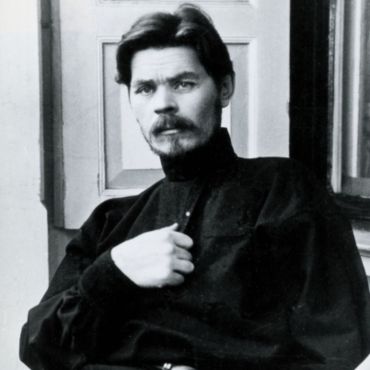
Maxim Gorky – his books My Childhood and My University are moving accounts of his life.
That is why I love the exhibition on at Bridget McDonnell’s Gallery in Carlton. Bridget is my sister, and visiting her gallery has always been a pleasure in which I can indulge in a healthy dose of creativity in one little place.
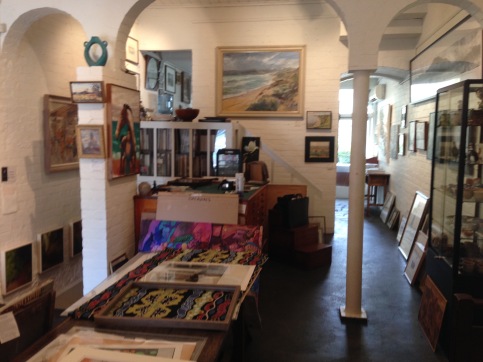
The busy interior of the Bridget McDonnell Gallery.
And that is how I stumbled on plein air English artist Nick Botting. The accuracy of his depiction of the bay, a sight I have always found quite mesmerizing, surprises me; the gradation of the colour of the water, the turbulent spring sky, the white froth of the waves as they roll to shore. I can almost smell the salt air.
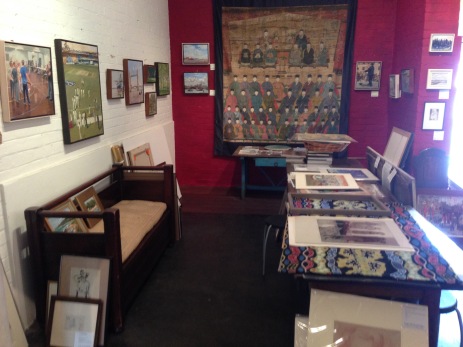
Some of Botting’s paintings can be seen on exhibition in the gallery.
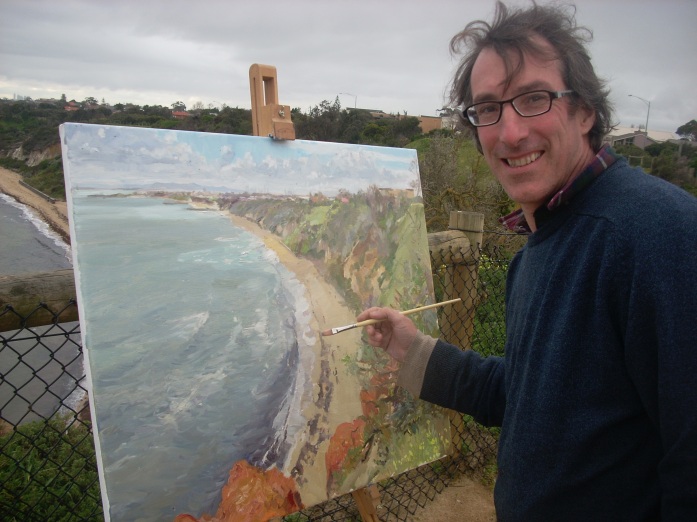
Nick Botting painting at Red Bluff, Sandringham.
What is even more surprising is that Nick Botting is a celebrated English painter who, going against traditions, has made many trips to Australia over the years to capture the unusual light and some of the nuances of life; interactions between people in restaurants, going to the theatre, hurrying home in the rain.
I met Botting while he was visiting Australia on one such painting tour.
“I think the tradition of Australian painters going to London painting – the traditional role – this is like reciprocal arrangements,” he quipped in a café in Hampton where he had retreated out of the bleak “English” day where he has been painting on the Sandringham foreshore.
Botting paints his subjects from life believing this “en plein air” approach allows for a more active engagement with the subject. His paintings feature such diverse subjects as the simplicity of a couple by the sea, or a judge enduring the tedium of a witness in court, to the complexity of an orchestra conductor in full flight.
“Painting is not like a photo. If you’re there you’re alive in the process of it, rather than doing it by association. Principally, to come all this way 12,000 miles and work from a photo would be potty, I think,” he said enjoying the warmth of his coffee mug, conceding, “It was getting a little wet out there.”
The challenge of painting from life is daunting for many artists, (unless they have a paid model, as people in life don’t stand still), but one that Botting has embraced. His ability to capture the essence of busy scenes has placed him in high regard in the very critical London art scene.
In England he was commissioned to paint the Australian cricket team meeting the Queen at Lord’s during the Ashes series in 2001, (this painting hangs in Lord’s museum, London) and he was the official artist for the 2001 English cricket tour of Pakistan.
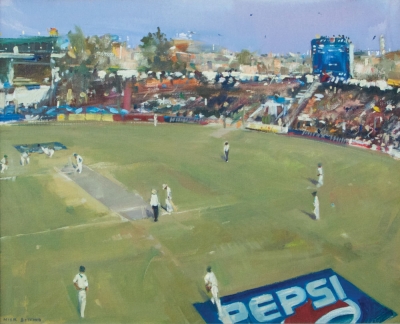
The third day of the English test series against Pakistan in 2000.
He has been the invited artist at the New English Art Club exhibition, an award winner at The Royal Institute of Oil Painters and was highly commended in the BP Portrait Prize at the London Portrait Gallery.
At the time, former Pakistan test crick captain Imran Khan celebrated Botting’s skill.
“It is incredible how he has summed up the tense moment of taking the wicket – you can sense it in the crowd and the batsman. And of course the stadium he has painted is my local in Lahore,” Imran said.
When asked of the experience of painting the Queen, Botting smiled recalling the scene. “That was quite a challenge because the Queen is tiny, she’s five foot nothing and all the cricketers are huge, so she looks like she’s standing in a hole.”
He said he found the session in the small room at Lord’s quite strange.
“I photographed her for that. That was really quite odd. I was less than two metres from her looking through the camera lens and you’re looking at the face that’s been on the stamp all your life, and here it is looking at you. It was really quite disconcerting.”
It was a sense of adventure that first brought Botting to Australia nearly 20 years ago.
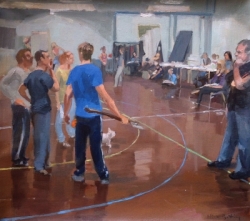
Rehearsals, The Wizard of Oz.
“I wanted to go where I’d never been before. I’d been introduced to Australian painters by a London art dealer John Barkes – to Tom Roberts and the early artists, and I was interested in the way they did things and the way they see the light -their treatment of the light. So I came here and bought a campervan and travelled around.
I went to Broken Hill, Tibooburra where Burke and Wills died, and Innamincka population 14 – on a road trip if you like.
“I did a big self-portrait in the outback. I went to a second-hand goods shop and bought a full length mirror and set it up in the middle of nowhere and did a big self portrait over a few days.”

Busker, Covent Garden.
On his return to England, the painting won a prize in the BP portrait awards at the National Portrait Gallery in London – the English equivalent to the Archibald Prize.
“As far as Melbourne is concerned, it’s quite nice to see somewhere when it’s not in the crackling heat, and in some ways more like London. I went into Pellegrini’s and Florentino’s and Lygon Street. That’s the quiet joy of sitting for a while and watching people come and go and you can pick the moment to reflect in the painting. It’s natural waiting for the action to come along. If you wait, something will always happen.”

Dome Reading Room, State Library Victoria.
“By travelling I get an enthusiasm for very ordinary things. It’s a fresh edge. It’s very exciting. I’ll sit there and draw and work out what is original to me about the idea.
A lot of it is a familiar thing. Yesterday I was painting in the rain – the road and tram tracks and the light catching the tram tracks and someone rushing across the road with an umbrella. The trams are something I’ve avoided because they’re so obvious – a tourist thing.”
Botting finds the energy, enthusiasm and humour of Australians quite refreshing.
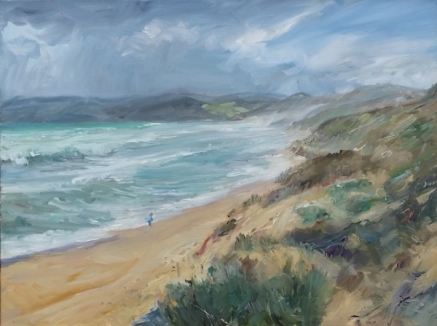
Windy Day Aireys Inlet, Victoria.
“I’ve had some of the funniest comments made to me while painting in Australia. For me, I do it everyday of my life and you get the same old things said. I thought I’d heard them all, but I was painting the other day and a guy said; ‘Cut your ear off and I’ll give you $100 bucks for it,’ alluding to the artist Van Gogh. Or while painting in Pellegrini’s; ‘I get it, so you paint them a picture and get a free meal!’ That’s great. When you think you’ve heard all the lines.”
It has also landed him in hot water on occasion.
“Are you allowed to paint in the law courts here? You’re not in England, I’ve gone in with a sketch book and pencil on the pretext of taking notes and been doing sketches, but they didn’t like it at all,” he says in that understated English way.
Did they throw you out? I ask.
“They didn’t just throw me out, the police dragged me off to the police station. They wanted to charge me!” he says indignantly.
Botting steadfastly paints from life. “I do a lot of sketches to try and get ideas. Clearly if a young child comes along the street and does a trick on the skateboard and some person comes along and topples over, and a child runs across the road and you put all that in a picture, it would look ludicrous. So you don’t do that, you watch and you might see one person do something and you might see other people do the same thing and you might paint that, but sometimes you miss it and that possibly is an argument for taking a photo, but then you’re looking at this blinking photograph.”
He looks outside at the dull day where a fine drizzle is falling.
“This light is really hard. With this light everything is grey. It can be hard. I’ve been painting at the Red Bluff (Sandringham). You could look down on the seaweed and the water was a cool grey green and the light catches it in pockets. It’s really lovely.”
While in Australia, Botting painted about 35 paintings, some of which are on exhibition at the Bridget Mc Donnell Gallery in Carlton.
“I love his ease with the subject matter and the beautiful way he moves paint around,” said Bridget McDonnell. “He manages to capture his subject with a few brushstrokes.”
 Bridget McDonnell Gallery is at 130 Faraday Street Carlton. Phone 0419 306 593.
Bridget McDonnell Gallery is at 130 Faraday Street Carlton. Phone 0419 306 593.

Enjoyed reading this interesting insight into a painters world.
LikeLike
I’m glad you enjoyed it Sandra. I loved the fact that, unlike the convicts who were sent out here as punishment, Nick travels to Australia regularly to celebrate our culture.
LikeLike